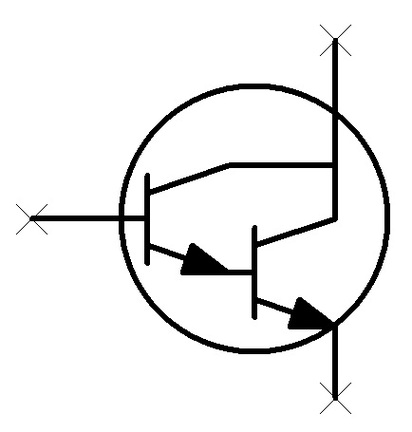
The base “cuts” the emitter and collector and the current goes straight through the base. It turns out to be a bit more of logic behind that one. The Swedish standard institute (SSI) symbol, from 1965, is depicted below the junction transistor. Looking at the international symbol, it does not really make sense – if one has time to care about those kind of things. Here the currents go “through” the semiconductor whereas in the point contact transistor it goes on the surface (well, arguably, but true to a first degree …). From left to right we have the emitter, base, and collector. The letters refer to the layers of semiconductor material used to make the transistor. To the right in the picture, we see a sketch of the junction transistor. There are two types of standard (bipolar junction) transistors, NPN and PNP, with different circuit symbols as shown.
#Transistor symbol free#
Free for commercial use High Quality Images.
#Transistor symbol download#
The “housing” around the transistor is modeled by a circle around the lines. Find & Download Free Graphic Resources for Transistor Symbol. The v-shaped piece of plastic, on which the phosphor-bronze traces where applied, guides the emitter and collector to and from the germanium plate which is attached to the metal frame which the base in turn is connected to. A transistor is a semiconductor device used to amplify or switch electronic signals and electrical power. Above that my redrawing of the famous Bell Labs photo. The symbol is found at the bottom left of the picture. It is pretty obvious from where the – today, widely used – bipolar symbol comes. I have depicted the first point-contact transistor (to the left) and the “first” junction transistor (to the right). Take a quick glance at my impressionistic skills below. So, in case you might be taking the course in analog electronics at the moment: this post aligns quite well with the topic we are currently reading. Where does the symbol come from? My short-story/interpretation. It was the 1965 version of the Swedish standard symbol for the junction transistor. Browsing through the pages, I realize that the transistor symbol he used in his figures looked unfamiliar to me. One of the books, “Praktisk transistorteknik” (1965), triggered me – of course. Kjell Jeppsson (from Chalmers University of Technology). Transistors are created by either stacking an n on top of a p on top of an n, or p over n over p.Together with Maple Martin I browsed through our group’s library and came across a couple of books by Prof.

A semiconductor material with extra electrons is called an n-type ( n for negative because electrons have a negative charge) and a material with electrons removed is called a p-type (for positive). Transcribed image text: What is the type of transistor symbol Draw the intermal structure diagram (indicate transistor terminals and materials in every.

Some of those layers have extra electrons added to them (a process called "doping"), and others have electrons removed (doped with "holes" - the absence of electrons).

Transistors are built by stacking three different layers of semiconductor material together. Using the diode (or resistance) test function on a multimeter, you can measure across the BE and BC terminals to check for the presence of those "diodes".) Transistor Structure and Operation (This model is useful if you need to test a transistor. There's a whole lot of weird quantum physics level stuff controlling the interactions between the three terminals. Don't base your understanding of a transistor's operation on that model (and definitely don't try to replicate it on a breadboard, it won't work). The diode representation is a good place to start, but it's far from accurate. The diode connecting base to emitter is the important one here it matches the direction of the arrow on the schematic symbol, and shows you which way current is intended to flow through the transistor.


 0 kommentar(er)
0 kommentar(er)
